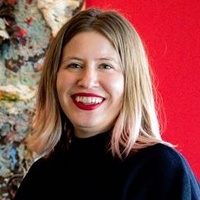Four people helped me write this essay
Prelude
Sarah Burke is a journalist and curator based in Brooklyn, NY. Her writing focuses on art, identity, social justice, technology, feminism, and the intersections therein. She is currently Special Projects Editor at Broadly, co-host of the podcast Queerly Beloved, co-curator of the series Living Room Light Exchange New York, and one fourth of the printing collective Irrelevant Press. Find her online as @sarahlubyburke.
Conversation
Four people helped me write this essay
An investigation of authorship, community, and the value of informal collaborations.
As told to Sarah Burke, 1608 words.
Tags: Curation, Writing, Process, Beginnings, Identity, Independence, Collaboration.
It’s perhaps tired, at this point, to dwell on the necessity of community as a condition for creativity. Even writing that word—community—feels almost passé in this context.
That’s in part because, if you’re like me, then you consider yourself having outgrown a wholesale belief in the myth of the brilliant, solitary genius. That is, the idea that truly great thinkers and artists are self sufficient—perhaps inspired by other people, but never reliant on them for success. We know, at this point, that many great artists require support from entire studios of apprentices, guidance from numerous mentors, and inspiration from generations of artists before them as well as their surroundings. We know that art is not—and cannot be—created in a vacuum. Maybe we can even agree that authorship is more an act of porous absorption than monolithic assertion.
It’s a more difficult thing, however, to internalize that sentiment. If you’re like me, then despite knowing all that, you may still subconsciously subscribe to an idea of authorship that implies the opposite. Informed, in part, by the investment framework of the art market, we still tend to appreciate cultural producers in terms of individualism—Who is most different, original, innovative? The value of an idea is often measured in terms of its distinctness, and the legitimacy of brilliance determined by its independence.
For those not working within explicitly defined collectives or socially engaged media, there is, then, a resulting pressure to lean into individualism while obscuring the ways that we lean on others. Rather than being acknowledged as part of the infrastructure that upholds a practice, the ways we may rely on other creative people—unofficially collaborating when we’re stuck, discussing ideas to make sense of them, keeping pace with others in order to keep ourselves going—are viewed as crutches, undermining the validity of the singular creative signature.
I only realized how much I relied on a localized creative network—and how much that reliance bothered me—after I left mine.
A few years ago, while living in Oakland, California, I quit my job among a tight-knit team of journalists in order to try freelancing full time. At first, as I sat at home and shot pitches into the digital void, I felt like I was disappearing. Soon, though, I settled into a routine of working at the same coffee shop every day. There, like an informal studio space, I’d run into a rotating cast of acquaintances and friends with their own creative practices and goals. Sometimes they’d be working a few tables down, sometimes they would join me, sometimes we would get lost in long conversations, and sometimes we wouldn’t acknowledge each other at all.
Something about the potential of that public space—the possibility of spontaneous collaboration—reminded me that I existed. It didn’t matter what the interaction entailed, if anything. Rather, it was about feeling situated within a network of people who simply recognized that I was a writer. That feeling of being seen by a social framework felt like the only way to convince myself that I was, in fact, a writer. And it worked: There, in that cafe, I developed enough confidence in my practice to move across the country in order to cultivate it further.
Upon arrival in New York City, though, I realized I had lost something I had taken for granted: that routine of acknowledgment and affirmation. Despite the unending number of new cafes and co-working situations to try, none were filled with familiar faces yet, and so none felt like being part of some unofficial collective. I knew it was only growing pains: I barely knew anyone; I was lonely. But it hit me hard. As I became increasingly uninspired and unmotivated, I became increasingly ashamed of my reliance on community in order to get my own work done. With the idea of the solitary writer involuntarily stowed away in some cabin in the back of my mind, I naively questioned whether any of my work had purpose beyond garnering personal attention; whether I ever even had the capacity for self-discipline; and what credit could be given to a writer whose ideas were necessarily spurred by conversations and collective experiences.
It’s this naive shame and association with softness, perhaps, that’s also at the core of our reluctance to utter that word, community. Being honest and open about our social needs for collaborators, mentors, or even just bodies around you as you work can be key, however, to getting your best work done. I’ve seen that made evident, especially in creative people whose projects and deadlines aren’t dictated by professional pressures.
In 2017, I collaborated with Holly Meadows-Smith on a project called Anti Lab, a creative resource center that encouraged non-artists to produce as much visual work as physically possible. Inspired by open-source software and online projects, we filled a gallery with artworks that were each designed to be replicated. So, along with each piece came the instructions, materials, and tools to recreate it. The intention was to build a factory of sorts, where none of the pieces had one author and the number of identical works made was so high that they’d all, theoretically, lose monetary value.
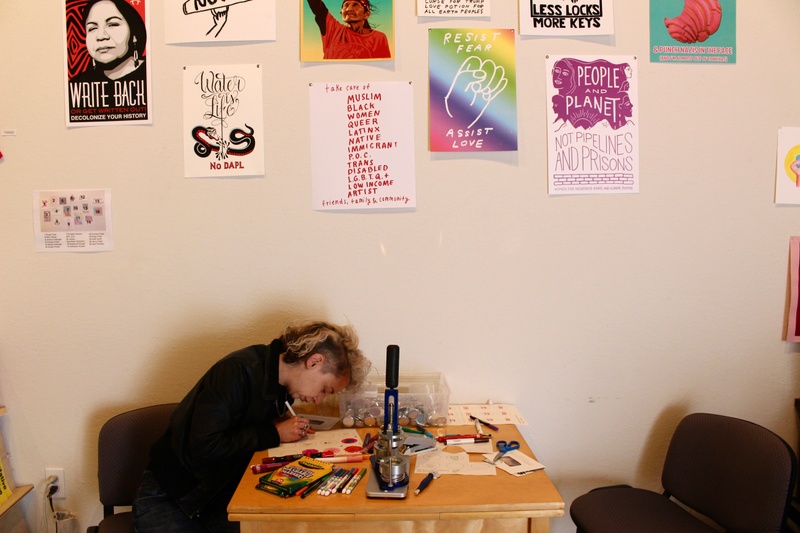
Anti Lab. Image courtesy Sarah Burke.
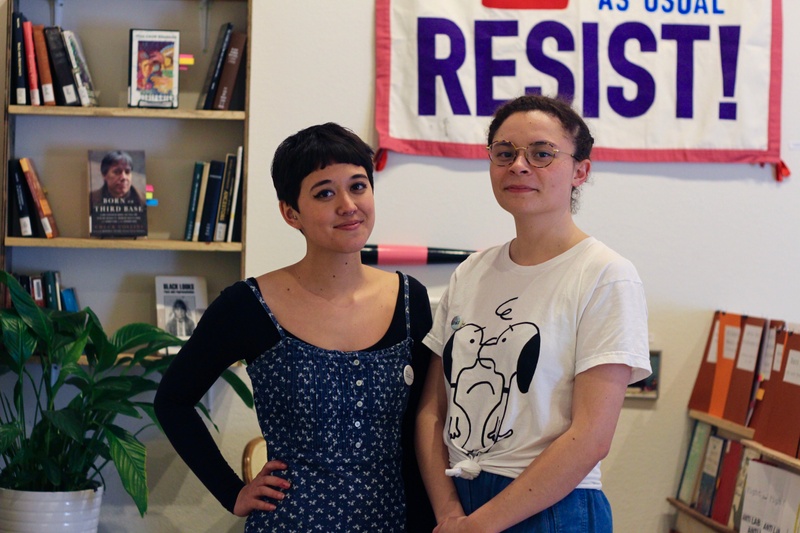
Sarah Burke, Holly Meadows-Smith. Image courtesy Sarah Burke.
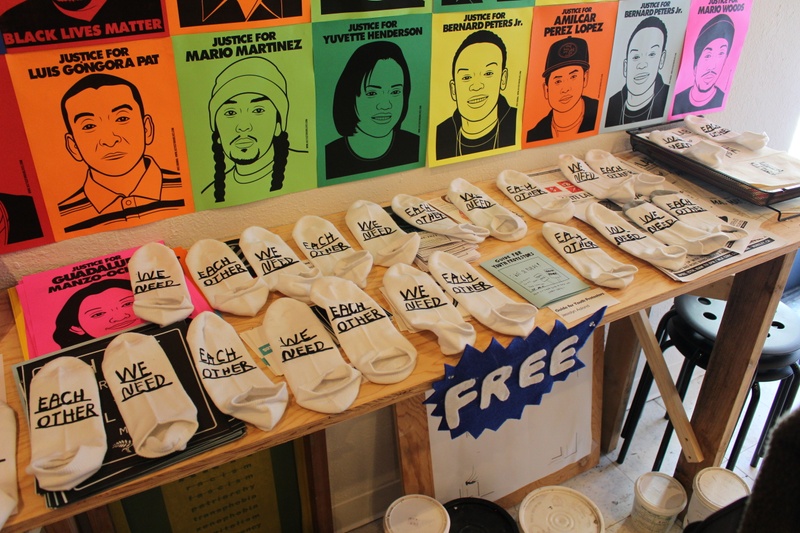
Free screen-printed socks by artist Carissa Potter. Image courtesy Sarah Burke.
Through that project, we weren’t arguing for artists to take up this model in all their work. Rather, it was an experiment to see how visually loud we could be, collectively. What we found is that inviting people to take direct inspiration from someone else’s work accomplished what we wanted it to: it inspired them to make things when they wouldn’t have otherwise, and dissolved the pressure to be original enough to draw out their own ideas.
Later, I found that a similar approach worked on me, too. One of the things that eventually got me out of my new-to-New York slump was volunteering to help organize a conversation series that I had nothing to do with ideating. I joined two (then) acquaintances of mine, Nicholas O’Brien and Jason Huff, in running Living Room Light Exchange New York (LRLXNY), an artist-talk format originally created in the Bay Area by artists Liat Berdugo and Elia Vargas. There was something liberating about working on a project that wasn’t mine, but that brought me together with other people, and supported the things that belonged to them.
The idea behind LRLXNY is to build creative social networks outside of institutions by having conversations about creative practice inside living rooms. Each month, someone new volunteers to host in their living room, three new media artists or creative technologists (the focus of the series is the internet and technology) are asked to speak about a work in progress, and everyone else shows up with drinks, snacks, and comments to contribute. The artists are invited to share their work casually, ask for feedback related to things they’re stuck on, and generally evaporate the air of having it all figured out.
Meanwhile, the audience is a grab bag of regulars, newcomers, and sometimers. And the night is just as much about conversation as it is about presentations. Sometimes, the discourse digresses into tangents that are only tenuously related to the presenter’s work. But that’s all part of the premise: Per Berdugo’s and Vargas’ original format, the night is only structured enough to optimize the potential for freeform conversation.
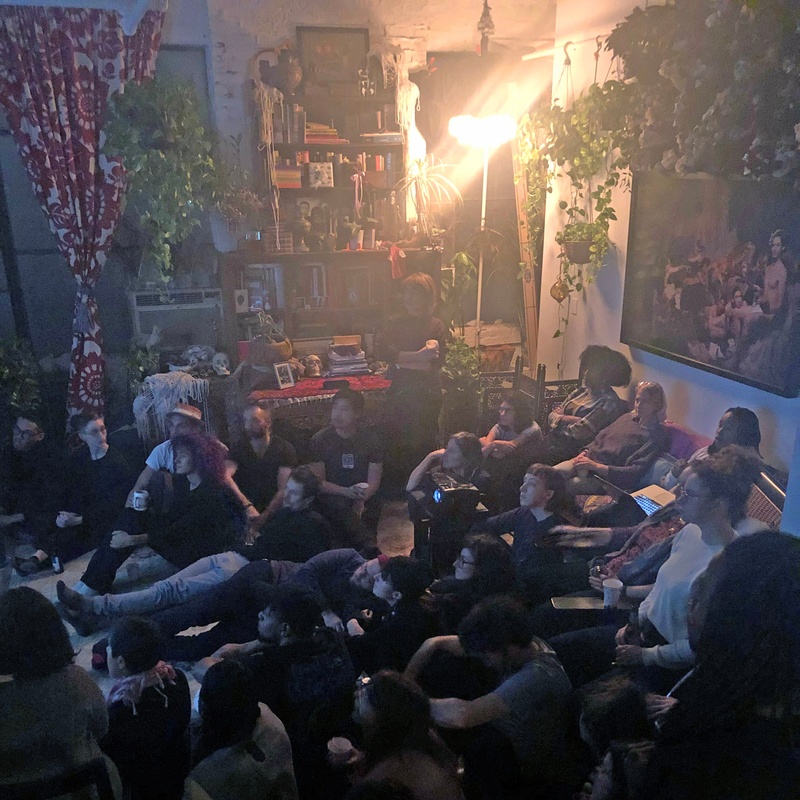
A Living Room Light Exchange event; Image courtesy Sarah Burke.
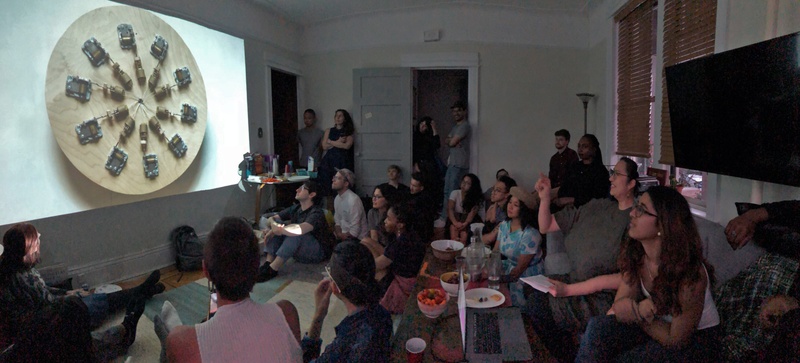
A Living Room Light Exchange event; Image courtesy Sarah Burke.
Curating LRLXNY got me motivated again because it was something to do and somewhere to be. But it also helped me think through my own needs as a writer and creative person. I’ve found that, sometimes, locating creative community is as easy as consistently showing up to a crowded coffee shop. Other times, it requires deliberately building out a structure of engagement with those around you that benefits everyone involved.
We don’t see informal collaborations on CVs, so it’s easy to forget how important they are. But truly, the grey area where those temporary collectives and social engagements exist can be deeply nourishing. Although it may feel contradictory to the narratives of independent, artistic brilliance that we’re used to, for me at least, surrounding myself with others has been the best way to figure out what I, alone, can contribute.
| Symbol: | Weather: | Music: | Location: | Emotion: |
 |
The kind of cold that makes you late for work | None, the only soundtrack I welcome while writing is "Rain Sounds NO Thunder" on YouTube | Talking with my collaborator over nachos, sitting in my office at home, lying on my best friend's couch | Tired, vulnerable, nostalgic, grateful |
- Name
- Sarah Burke
- Vocation
- Journalist, Curator
Conditions report at the time of writing this essay
Pagination

